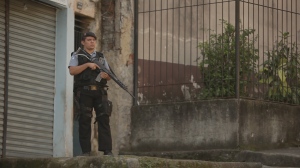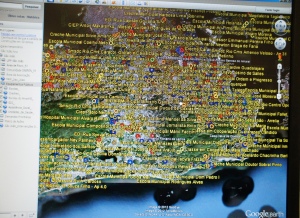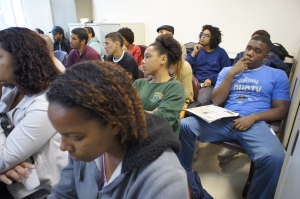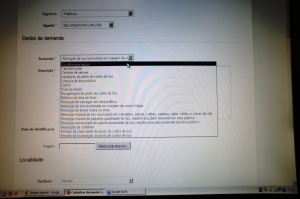Still, it needs a significant upgrade, evaluation says
Ever since pacification began in Rio de Janeiro, in November 2008, we’ve been hearing (and saying) that social needs must also be met. As the number of UPPs, or police pacification units, grows (now at 26, employing 5,000 men and women, with a goal of 40 by 2014), State Public Safety Secretary José Mariano Beltrame– and many others– repeat the mantra about the other side of the coin.
The Social UPP got off to a shaky start, with Governor Sérgio Cabral’s political needs shoving it out of the state nest in December 2010, into the municipal one, under the aegis of the Pereira Passos Institute. From day one however, it’s been run by Ricardo Henriques (who next week hands his post over to former Municipal Finance Secretary Eduarda La Rocque, who is to keep on current director Tiago Borba) and a growing team, in partnership with the U.N. Habitat program.
Centuries of neglect and the mantra repetition have led to the general perception in Rio that police pacification is dangerously outpacing the city’s ability to meet social needs.
But the first wide-ranging examination of the impact of police pacification reveals that though it has significantly reduced violence in and around UPP communities, the project that lies at the core of Rio’s remarkable turnaround needs extensive reform itself.
Fortunately, the police are listening. Study coordinator Ignacio Cano, with a long history of research in the area of public security and human rights, is now in dialogue with the men and women in uniform. Hopefully, they’re poring over his ‘Os donos do morrro’: uma avaliação exploratória do impacto das unidades de polícia pacificadora (UPPs) no Rio de Janeiro [‘The owners of the hill’: an exploratory impact evaluation of the police pacification units].
“Just a decade ago, whether in training or research, the police in general wanted little to do with the academic community and flatly rejected or refused to cooperate with researchers,” observes Liz Leeds, founder of the Brazilian Forum on Public Safety and creator of the Democratic Policing Initiative when she was a Ford Foundation program officer in Rio, in the early 2000s. “Today that cooperation is not only possible but frequently sought after by the police,” continues Leeds. “Of course, the police are not always happy with the results of independent research when the conclusions are negative. It is a process that involves the gradual break-down of long-held mutual mistrust and prejudice between the two communities”.
Optimism
Cano’s study, funded by the Caracas-based Development Bank of Latin America by way of the Brazilian Forum on Public Safety, took great methodological pains in comparing crime statistics. Which makes it particularly heartening to find that statistics for UPP communities, for police stations serving them and for their geographical surroundings, all show that UPPs significantly reduce lethal violence. Interestingly, they also increase non-lethal crime: robberies and such may be on the rise now (and/or being reported more) because the iron-fisted rule of drug traffickers is ending.
In UPP favelas alone, pacification saves an estimated 60 lives a year per 100,000 inhabitants. This translates to 177 lives hypothetically saved per year in the city’s favelas, given that the UPPs currently serve a total population of 295,415.
At 227 pages, the study is a long read. But it’s a worthwhile investment because the numbers and analysis basically demonstrate that UPPs are pacifying the police and strengthening their institutional role in society. Because of UPPs, police killings are significantly down. Inside and near UPP favelas, this is the single most significant factor in reduced lethal violence. In addition, UPPs may lead cariocas to feel more compelled to report non-violent crime than they did before.
Another reason the study is a must-read are the excerpts from interviews carried out with favela residents, community leaders and police from a variety of levels of the hierarchy. This qualitative data provides valuable windows to the changes under way in Rio. For example, pacification has allowed some favela residents not only to come and go freely in their own communities, but also to at last visit those formerly belonging to “enemy” factions. The interviews also shed useful light on topics such as funk dances and mototaxis, both murky areas of conflict between UPP police and favela residents.
Pacification was undertaken with a reasonable amount of planning, described in this two-year-old Piauí magazine article. It has achieved so much. But, says the study, the model needs further development. From some of the police interviews and from press reports and unfolding events, it’s become clear that the program is in many respects rather slapdash. Last week the first UPP officer was shot dead, wearing a not-so-bulletproof-vest and working in a container as an operational base. Later, other officers complained that the donated rifles they used to defend themselves against the attack, allegedly undertaken by drug traffickers, had jammed.
Of course pacification is a pioneering effort, bumping up against many unexpected challenges and outcomes, and so must be flexible. But it seems the time has come to buck the Brazilian penchant for improvisation.
Fifty years in five? Or six?Meanwhile, the mantra about social services keeps on being repeated.
No large-scale impact study of the Social UPP has been undertaken or is under way. It’s quite a bit easier to quantify violent deaths than to measure social needs and how much they’re being met– not least of all because live people have conversations.
“Dialogue with results is possible, and is a continuous exercise,” Ricardo Henriques told RioRealblog on one of his last days on the job. Knowing how to listen critically he added, is key. Job training for youth was a top demand in one pacified favela, for example, but it turned out the area did have job training, with empty classrooms. “It’s a question of matching, of information flow. You have to have a lot of information about a community,” he said.
As Henriques spoke, Gustavo Ferreira, responsible for the Social UPP’s Fast Participatory Mapping of UPP Favelas, swiveled a computer screen and brought up a Google Maps-based product of the program’s 11 field teams in 20 territories. Work began a year ago, with the help of consultant Francesco di Villarosa. The teams take photographs, make observations and interview residents, leaders, NGO agents, and public service providers. Results change constantly and are analyzed so as to pass on demands to agencies who can and should be meeting them. The Social UPP also works with NGOs and the private sector.
Among other data, the maps show which parts of favelas are at risk for mudslides and the like. Most impressive are the photos of contemporary housing that looks like something out of the film Black Orpheus. Not all favela homes today are made of brick and cement.
If all the mapped data were to be posted on the Internet it could clear up a great deal of doubt about life in pacified favelas and the challenges they present to the city of Rio– for people who live in them and for those who don’t, as well. Making this data available to researchers would also open the door to an impact study.
When President Juscelino Kubitschek got it into his head to build Brasília in the 1950s, he spoke about pushing the country ahead fifty years, in only five. What Rio is doing to prepare for its growing list of megaevents is a comparable task: police manpower has grown exponentially over the last few years, with shortcuts in preparation that they themselves fault. The Military Police force for all of Rio state, including 5,000 pacification police, totals 40,000-plus today and is set to grow to 60,000 by 2014.
Setting up police pacification units (guys with guns in snappy uniforms, who’ve had six months’ training) looks a great deal easier than mapping and meeting needs for trash collection, health care, public lighting, education, day care, legal aid, and so much else. But it may well turn out that both sides of the coin are equally challenging.
Perhaps it’s time for a new mantra? Here are the UPP impact study’s recommendations to Rio’s pacification police force:
1. Include local homicide rates in the criteria for selecting new UPP areas. This could have a systemic effect, sending a message to organized crime to bring down the violence level or “lose” their territories.
2. Systematize working criteria and procedures. Police and residents need to know how disturbances of the peace, mototaxis and funk dances are to be dealt with, for example. Police need to know what to do when children describe drug use at home, and what types of performance will be rewarded.
3. Improve work facilities and reformulate pay bonuses. Current pay delays damage morale.
4. Intensify and improve training. One or two weeks of proximity policing techniques cannot undo pre-formed values and behaviors.
5. Take measures to legitimate police pacification within the Military Police. Police lethality reduction goals, linked to bonuses, would help to mitigate the rejection of UPP police by the rest of the force.
6. Rethink police response to drug crime. The change in focus from drugs to weapons should be more complete and even-handed, and the police should no longer repress drug-use-related cultural manifestations such as funk dances as if these were enemy territory. In doing so they will gain the trust of young people, who now often consider their actions arbitrary and unjust.
7. Deepen the community component of UPPs. There should be more interaction between police and residents, at all levels. This will increase police identification with the project.
8. Promote mechanisms for community decision-making. This should help fill the authority vacuum left by drug traffickers, which police have been stepping into in an irregular and controversial manner.
9. Promote community representation and political participation. The study points out this missing element in the pacification equation, adding that a police role is questionable for this item, though it should be taken into consideration as other issues are sorted out.
Stay tuned for more on this subject, once RioRealblog has had a chance to speak with pacification police officials on their reaction to the study and what they’re doing to develop the program further.
For more information, check out this powerpoint presentation of the CESeC police opinion survey results and this MIT Master’s thesis on police pacification and governance transformation.






Pingback: Editorial: Flying by the Seat | The Rio Times | Brazil News
Great!
There’s a discrepancy for murders in Rio between the police and DATASUS, not sure if you’ve noticed this. They actually increased in Rio during 2010 according to DATASUS and decreased significantly if you use police numbers (I have no idea about 2011, the DATASUS prelim. data is delayed it’s normally out by now).
I point this out because many people and lazy media outlets are rather foolishly using the police numbers, which are likely to be doctored.
The SUS data have their own problems. Says Ignacio Cano: “The proportion of violent deaths of unkown intentionality (i.e. could be accidents, suicides or homicides) in SUS data has increased sharply in Rio since July 2007. That means that any homicide estimate based on those data will be severely underestimated (i.e. we know a reasonable proportion of those violent deaths of unkown intention are indeed homicides but they will not be counted)”